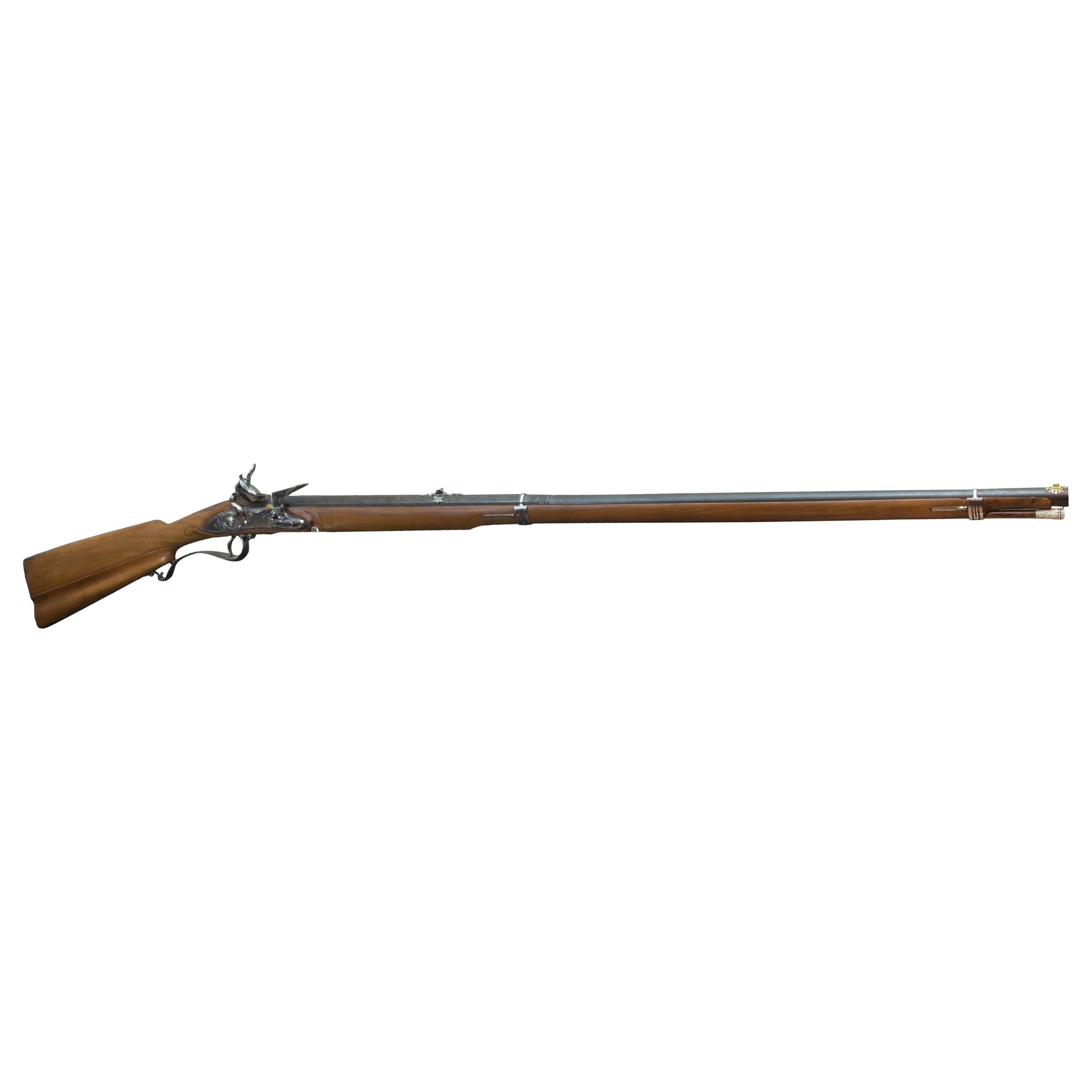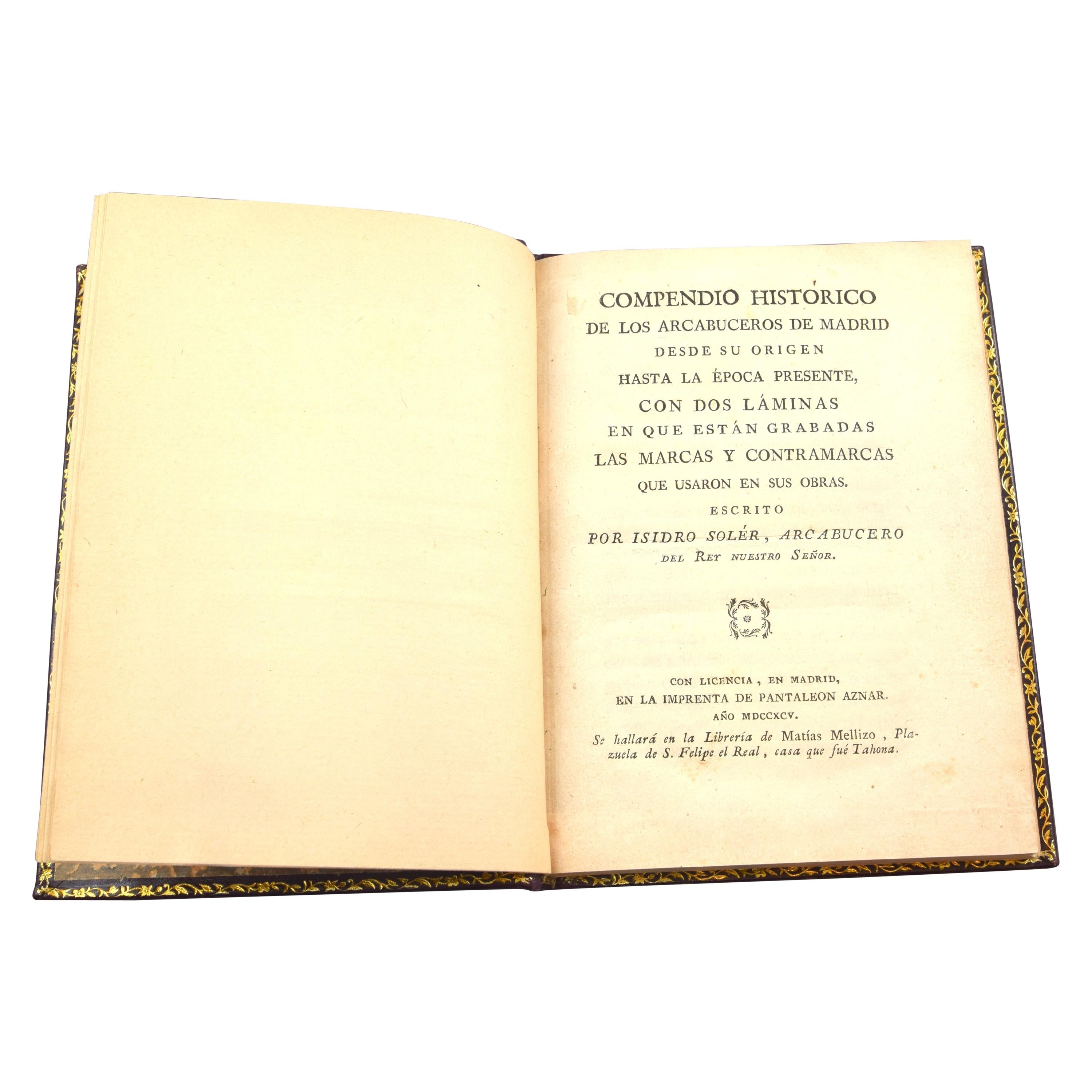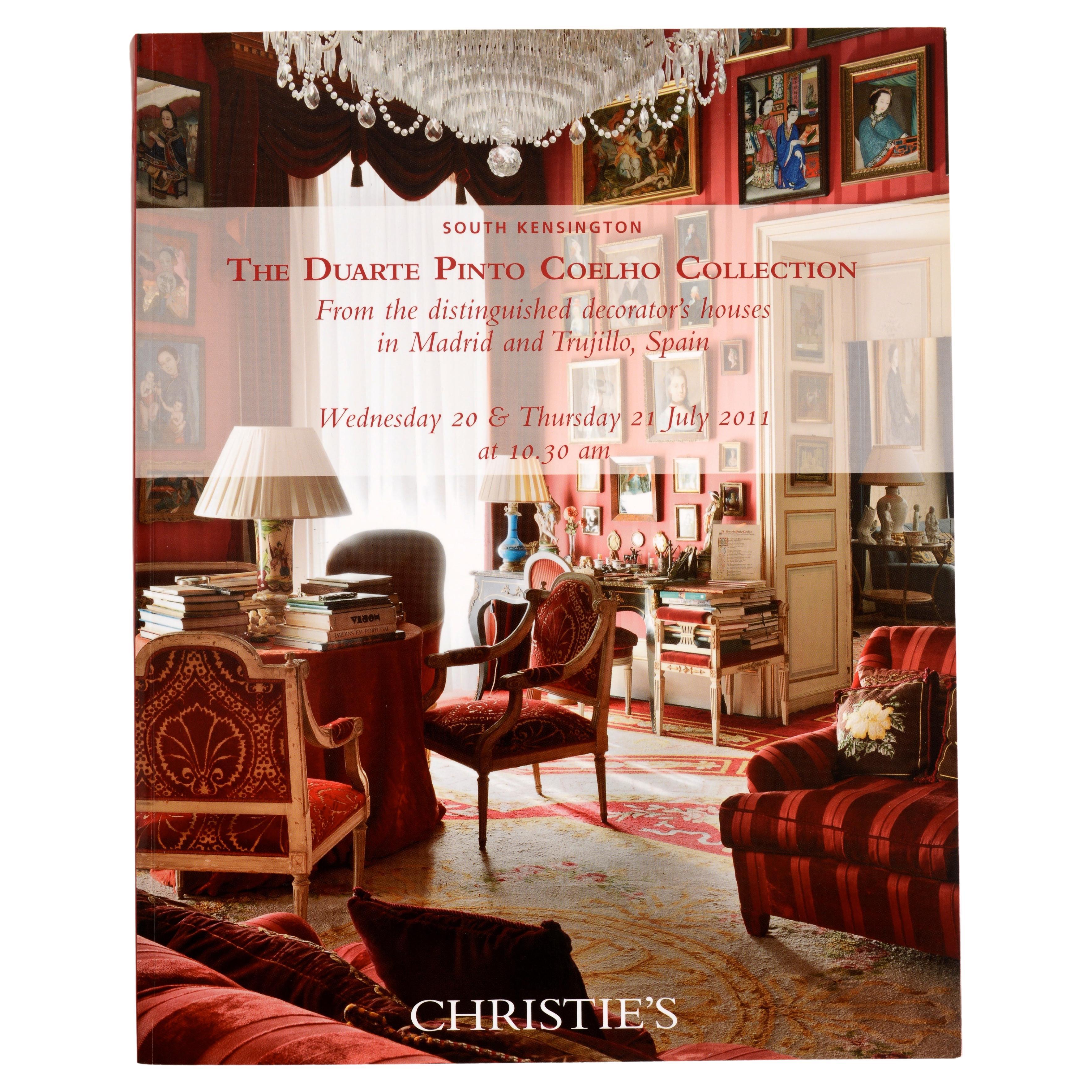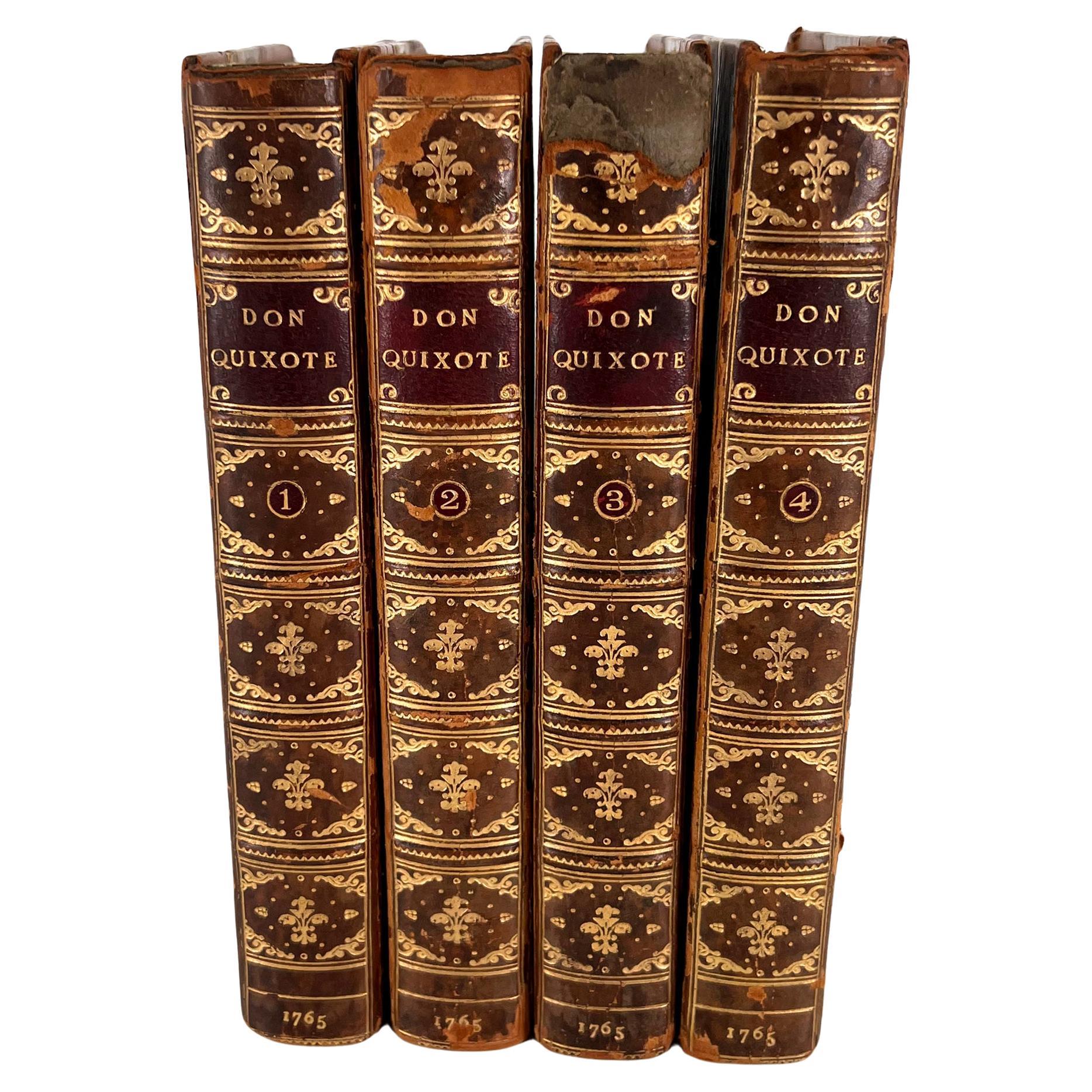Items Similar to Arquebus. Miguel de Zegarra. Madrid, Spain, 1773-1774.
Want more images or videos?
Request additional images or videos from the seller
1 of 13
Arquebus. Miguel de Zegarra. Madrid, Spain, 1773-1774.
About the Item
Marks: cannon (inscription, trademarks and countermark); key (punch); trigger guard (punch); medal with rope (inscription).
Date: 1774 cannon; key of 1773.
Author: Miguel de Cegarra.
Origin: Madrid, Spain.
Material: wood, steel, gold, other.
Techniques: forged; carving; molten; possible chiseled; engraved.
Miguel de Cegarra was a master documented between 1764 and 1783, who was named honorary arquebusier of Carlos III on May 4, 1768, and number on July 11, 1711. He trained with Gabriel de Algora and, in turn, was master of Antonio Navarro. He died on January 22, 1783.
The appreciation that was held in court by Miguel de Cegarra is clear with events such as Carlos III's request to this master armorer and Salvador Cenarro to create an arquebus in his presence and that of his children, so that they could contemplate and value the work and the technology of the pieces. It should be noted that the arquebusiers were not subject to guild organizations, but the Ballestería de la Real Armería (Madrid) could have exercised certain tasks of control (including the collection of the "marks", once the arcabucero master died, to re-mark the gold plate of the brands of weapons, when they wear out by use).
With his trademark, in addition to a few specimens in prominent private collections, there is a shotgun in the Municipal Museum of Madrid (number 6285) and another three in 1774 at the Museum of Applied Art in Milan, in the arsenal of Gatchina in St. Petersburg in Russia (inv 685) and another in what he called "Neal Collection", respectively. A shotgun of the Palace of Viana de Córdoba (inv 12) presents the cross punch attributed to the master. A document of the Royal Armory ("Ballots that were in the drawers of the Armory of the Royal Ballestry from the Ymbiente that was made on September 20, 1790 to the one that was made on January 3, 1801"), states that the institution had among its funds a "regular arcabuz" of the teacher. Both the honorary and number arabuceros, in the eighteenth century, worked exclusively for the royal service (requiring authorization for orders from individuals outside this circle). The first did not receive a salary, but their works were well paid and could access the arcabucero number square when the owner of the place died, presenting himself to a test (show a shotgun before the senior stableman, the main crossbowman and other arquebusiers, who valued mainly the quality and safety of the cannon).
Size: Long 137 cms. Max depth 7 cm; max height 22 cm.
- Creator:Miguel de Zegarra (Maker)
- Dimensions:Height: 8.67 in (22 cm)Width: 53.94 in (137 cm)Depth: 2.76 in (7 cm)
- Style:Neoclassical (Of the Period)
- Materials and Techniques:
- Place of Origin:
- Period:1770-1779
- Date of Manufacture:1773-1774
- Condition:Wear consistent with age and use.
- Seller Location:Madrid, ES
- Reference Number:
About the Seller
4.9
Vetted Seller
These experienced sellers undergo a comprehensive evaluation by our team of in-house experts.
Established in 1985
1stDibs seller since 2017
292 sales on 1stDibs
Typical response time: 16 hours
- ShippingRetrieving quote...Ships From: Madrid, Spain
- Return PolicyThis item cannot be returned.
More From This SellerView All
- Spanish Arquebus, Salvador Cenarro, Madrid, 1761-1793Located in Madrid, ESMarks: In key, chamber of the cannon and trigger guard. Date: between 1761 and 1793. Author: Salvador de Zenarro. "Real Arcabucero". Origin / Provenance: Madrid, Spain. Material:...Category
Antique Late 18th Century Spanish Neoclassical Arms, Armor and Weapons
MaterialsGold, Steel
- Compendio Historico De Los Arcabuceros De Madrid, Soler, Isidro, Madrid, 1795By Isidro SolerLocated in Madrid, ESHistorical summary of the arcabuceros of Madrid ... Soler, Isidro (fl. circa 1795), Madrid, 1795. Original, leather binding. 86 pages perfect state of conservation. "Historical Comp...Category
Antique 1790s Spanish Neoclassical Books
MaterialsOther
- “Saint Roch” Polychromed Wood, Juan de Anchieta’s Circle, Spain, 16th CenturyLocated in Madrid, ESThe bearded male figure appears with the angel, showing the wound or plague on his leg, with the hat and the pilgrim's cloak and the dog with the loaf of bread placed under one of his feet in a quite unusual way. All these attributes help to identify the image: Saint Roch (San Roque...Category
Antique 16th Century Spanish Renaissance Religious Items
MaterialsWood
- Bronze Mortar with Inscription, Spain, 1846Located in Madrid, ESMortar with inscription. Bronze. Spain, 1846. Mortar made of bronze with flared mouth and truncated cone body developed without discontinuity and decreasing in diameter to the base....Category
Antique 1840s Spanish Neoclassical Scientific Instruments
MaterialsBronze
- Silver Jar or Jug, De San Faurí, Juan, Spain, Madrid, 18th CenturyBy Spanish ManufactoryLocated in Madrid, ESJug or jug. Silver. DE SAN FAURÍ, Juan (1745-1785). Spain, Madrid, towards the last third of the 18th century. With contrast and burilada marks, and property name (Ochoa). The jug has an oval base with slight curves and a body divided into two areas (wider in the lower half, slightly concave in the upper half) with a series of curved “gajos”; the peak shows simple architectural decoration and smooth areas; the handle is of a type known as brace, with classicist architectural elements; the lid follows the lines of the body and is finished off with a vegetable shape creating a knob. On one of the sides, towards the foot, there is the engraved text "Ochoa", referring to a former owner. Contrasting marks place the creation of the piece in Madrid. Another one that appears could be one of those used by the silversmith Juan de San Faurí. With Felipe V, numerous French influences, along with some Italian ones, came to silverware, both from the hand of craftsmen of these origins and from pieces. Little marking continues in the works, except in important centers such as Madrid, and civil typologies acquired great importance. As in the rest of the country, the Baroque, Rococo and Neoclassical tendencies coexisted at the Court, although, being the center that set the standard for the rest, the former soon departed, introducing Rococo before 1740 or on that date, and Neoclassicism around 1770 (gradually imposing itself from 1780). The jug follows the most common prototype since the arrival of the Bourbons, characterized by its European influence and the great difference it shows with the type known as the “spout jug”. Compare with the Francisco García...Category
Antique Late 18th Century Spanish Neoclassical Serving Pieces
MaterialsSilver
- Silver Salt Box, Lizasoain, Spain, Madrid, 1768By Spanish ManufactoryLocated in Madrid, ESSalt or spice shaker. Silver. Lizasoain. Spain, Madrid, 1768. With contrast markings. Silver spice rack in its color with a frustoconical body, sinuou...Category
Antique 1760s Spanish Neoclassical Decorative Boxes
MaterialsSilver
You May Also Like
- Madrid 1901: A Historical Map of Spain's Capital ProvinceLocated in Langweer, NLThe map is of the province of Madrid, the capital region of Spain, as it appeared in 1901. Here are the key features it displays: The map shows the central part of Spain, with the Guadarrama mountain range prominently visible, marking the natural border to the north of Madrid. Blue lines likely indicate rivers, including the Manzanares River, which flows through Madrid, and the Jarama River, a tributary to the Tagus. Red lines depict the roads and railways, outlining the infrastructure that connects Madrid's various towns and cities within the province and beyond. Symbols and labels mark the locations of cities, towns, and villages, with Madrid itself likely being the focal point. Dotted lines may represent the administrative divisions within the province. The map includes a legend (Signos Convencionales) that explains the symbols used for provincial capitals, roads, railways, and other geographic features. The coat of arms of Madrid, featuring a bear and a strawberry tree (madroño), is prominently featured, symbolizing the city's and the province's historical coat of arms. About the province of Madrid: Madrid is not only the capital of Spain but also the heart of the Iberian Peninsula, both geographically and politically. The city is renowned for its rich repositories of European art, including the Prado Museum's works by Goya, Velázquez, and other Spanish masters. The province of Madrid is characterized by a blend of historical and modern elements, with a rich cultural life that includes theater, opera, and flamenco, as well as gastronomy that features a mix of traditional Spanish dishes and international cuisine...Category
Antique Early 1900s Maps
MaterialsPaper
- Christie's: 2011, Duarte Pinto Coelho Collection, Madrid & Trujillo, SpainLocated in valatie, NYChristie's: 2011, Duarte Pinto Coelho Collection, Madrid & Trujillo, Spain. 1st Ed auction catalog with 753 lots all photographed in color and fully descr...Category
21st Century and Contemporary English Books
MaterialsPaper
- Original Antique Print of a Castle in Madrid, Spain, 1833Located in Langweer, NLAntique print titled 'Schloss zu Madrid'. Lithograph of a castle in Madrid, Spain. This print originates from 'Neuen Bildergalerie für die Jugend'. Artists and Engravers: Ano...Category
Antique 1830s Prints
MaterialsPaper
- Cervantes, Miguel de — Don Quixote — 4 volume setLocated in Middletown, NY4 vols.; 8vo, 6 1/2 x 4 in. (165 x 102 mm) , vol. 1: (6), xl, 293; vol. 2: (1), 314; vol. 3: 910, xi, 331; vol. 4: 91), 322. With 28 copperplate engravings designed by F. Hayman and engraved by G. V. Neist; all are signed by both artist and engraver; all have “Vol” and “p.” indications, except those for Vol. I., which have “p." indications only. Three-quarter tan calf binding with marbled paper, all edges stained yellow, gilt title, decorations and raised bands on spine. The antique bindings...Category
Antique Late 18th Century English Books
MaterialsLeather, Paper
- Antique Print of Egyptian Objects, 1773Located in Langweer, NLUntitled print depicting various Egyptian objects including statues. Originates from the first Dutch editon of an interesting travel account of Northern Africa titled 'Reizen en Aanm...Category
Antique 18th Century Prints
MaterialsPaper
- Antique Print of Spanish Inquisitions in Madrid and Goa by B. Picart '1723'By Bernard PicartLocated in Langweer, NLAntique print with two religious images on one sheet. 1. Iugement de l'Inquisition dans la grande Place de Madrid, 2. La Procession de l'Inquistion, a Goa'. Antique print depicting Spanish inquisitions...Category
Antique Early 18th Century Dutch Prints
MaterialsPaper





